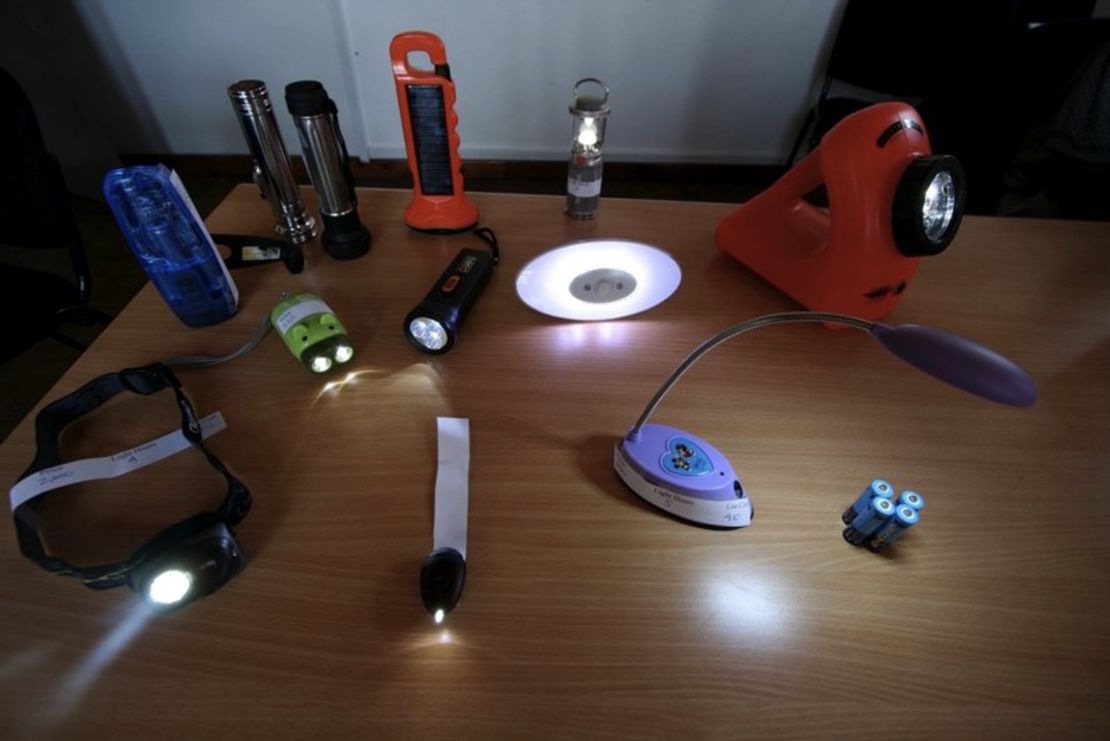Story highlights
A fifth of the world's population still live without access to electricity
After dark, most rely on the light from kerosene and other fuel-based lamps
However, Kerosene is toxic, polluting, dim and very expensive
Now a new market has opened in developing world for solar-powered LED lamps
When the sun goes down over large swathes of the developing world, the 1.3 billion people currently living without access to an electricity connection are plunged into darkness.
According to figures from the International Energy Agency, at least 20% of the planet’s inhabitants are still without the simple luxury of a light-switch.
From the shantytowns of Sub-Saharan Africa to the sprawling slums of the Indian sub-continent, night-time brings with it a noxious ritual of candles, gas lamps and open fires.
“Fuel-powered light is dangerous, polluting, expensive and dim,” says Dr Evan Mills, founder of the Lumina Project, an initiative that promotes low-carbon alternatives to fuel-based lighting in the developing world.
According to studies conducted by Mills and his colleagues at the Berkeley Laboratory at the University of California, this “dirty light” consumes 77 billion liters of fuel worldwide, costing its predominantly impoverished end-users a total of $38 billion annually.
And they don’t call it dirty for nothing. If a single kerosene lantern burns for an average of four hours a day it emits over 100kg of CO2 a year, says Mills. “The combustion of fuel for lighting consequently results in 190 million metric tonnes of carbon dioxide emissions, equivalent to one-third the total emissions from the UK,” he adds.

Patrick Avato, director of the Lighting Africa program – focused on developing commercial off-grid lighting markets in Sub-Saharan Africa – says that what’s toxic for the atmosphere is no less toxic for the lungs.
“Indoor air pollution from kerosene wick lamps can cause fatal respiratory problems over time,” he says. “Deaths from accidental fire are also all-too common, particularly among cramped, built-up settlements.”
Adding insult to injury, the quality of petrol-fueled light is grossly inferior to its electric counterpart. “If you’re trying to read or work, the murky light produced by a candle or gas lamp is not very useful,” says Avato, who is also energy and climate change specialist for the International Finance Organization.
Mills puts the problem in numbers. He says that those without electricity pay hundreds of times more per lumen – the unit measurement of visible light emitted by a source – than those who enjoy free-flowing electricity.
“In real terms, they contribute a fifth of all the money spent on lighting globally, but get less than 1% of the total lumens,” he says.
While it might seem that the obvious solution is to expand electricity grids, in recent years more environmentally sustainable and immediately accessible alternatives have emerged. Chief among them is the solar-powered light emitting diode (LED) lamp.
“When we started out 15 years ago, there were no scalable solutions – large energy-hungry fluorescent bulbs required large, expensive solar panels and complicated installation” says Mills. “Now, LEDs the size of a cherry can generate light 100 times brighter than a kerosene lamp at a very low wattage, while solar cells have become much more efficient.”
As production costs fall, a burgeoning industry has formed to provide cheap off-grid lighting solutions to a potentially vast market scattered throughout the developing world.
Read-related: Plastic bottles light up lives
Amit Chugh is co-founder of Cosmos Ignite – a New Delhi-based start-up who developed the “MightyLight” – a hard-wearing, portable and waterproof lamp that runs for 12 hours on a single solar charge and retails for just $25.
“There are now about 100,000 people using the lamp worldwide … from kids doing their homework to grocery stall owners who want to stay open after dark,” says Chugh, who was inspired to develop the product after witnessing first-hand the hardships caused by light deprivation in his native India.
“You have some night-fisherman spending up to a dollar a day on kerosene – a huge chunk of their income. If they buy a solar lamp they’ve potentially recouped their investment in a month or so, freeing-up extra money to invest in their business,” he says.
Influenced by C.K. Prahalad’s book “The Fortune at the Bottom of the Pyramid” – championing the collective buying power of people earning a few dollars a day – Chugh and his American founding partner Matt Scott have predicated their business model on the idea that world’s poorest can be the drivers of commercial innovation.
“The MightyLight is really a co-creation with the target users. We developed it exactly how they wished it to be … and the result is a product that would appeal even to the wealthy in New York,” he says.
According to Avato, it’s this focus on entrepreneurship – as opposed to aid – that has underpinned much of the progress around off-grid lighting over the last few years.
“It’s taken a while to convince investors that there is a viable market here. But you just have to look at the figures – Africans alone spend $10 billion a year on kerosene, and there are 600 million people without electricity,” he says.
At the recent Lighting Africa Conference in Nairobi, Avato claims there were over 50 companies promoting their off-grid lighting products – up from just a handful only two years ago. This, he says, has helped enable 1.5 million people across the continent to acquire some form of cheap, off-grid, renewably powered light.
“The market is proving to be a more effective mechanism at providing long-term solutions than government or NGO aid,” he says.
For Mills, the entrepreneurial model in this case has both social and environmentally practical benefits.
“Rather than the old ‘relief’ mentality around solar where you have charitable organizations dumping these lights from a helicopter, you now have individuals making small investments for themselves and yielding big returns. It’s a more sustainable model that fosters aspiration,” he says.









